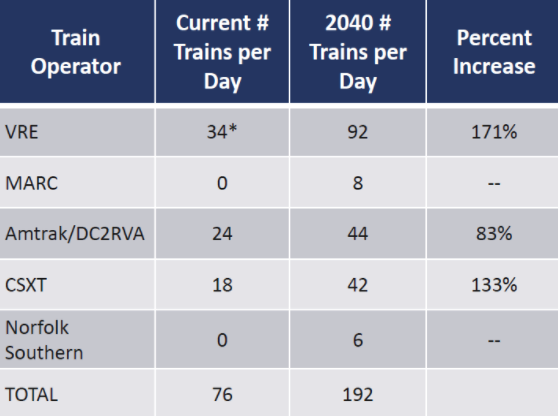The new Long Bridge could have bike and pedestrian paths

The Long Bridge. Image by Elvert Barnes licensed under Creative Commons.
The railroad bridge between DC and Virginia is 113 years old, and in need of replacement. Options for doing that include bridges with three, four, and five tracks, each of which could also include bike and pedestrian paths.
The Long Bridge is a two-track railroad bridge that crosses the Potomac from Arlington, Virginia to southwest DC. Amtrak and VRE trains use the bridge to reach Union Station, and CSX freight trains (CSX owns the bridge) use it get into the District en route to a track that leads toward Baltimore.
The bridge doesn’t work very well these days. Not only is it old, meaning there are structural issues, but it’s also a chokepoint for the different train lines that use it, limiting how many trains can be run between Virginia and DC. 76 trains use the bridge every day currently, but up to 192 are expected to want to cross it by 2040.
If a replacement bridge allowed for more trains to use it, VRE could run bi-directional rush hour service both to and from Union Station, which it can’t do now. There would be additional capacity for Amtrak to run more long-distance trains from the south into DC, as well as additional service inside the state to Richmond and points beyond. And CSX would be able to run more freight trains (although that might not be needed as much once the Virginia Avenue Tunnel expansion project is finished).
For the past few years, the District Department of Transportation has been working with the Federal Railroad Administration to study potential new bridges or tunnels to replace the current span with, in order to fix the issues listed above.
One possible design for the Long Bridge, from an earlier study. Image by DDOT.
The project team produced a set of “conceptual alternatives” for replacing the bridge, settling on the following criteria:
- The replacement should add train capacity.
- The replacement should maintain/improve connectivity to the passenger/freight rail network and integration with local county, state, and regional transportation plans.
- The replacement should make it easier to maintain service during planned maintenance or emergency track outages.
On Tuesday, DDOT and the FRA held an open house to show which of the options they’ve considered match the criteria:
The project team narrowed down the 19 initial options to just 7, one of them being the “no build” option that would keep the existing bridge in use. The remaining options include 3, 4, and 5-track bridges, each both with and without an accompanying bike/pedestrian path.
DDOT and the FRA had looked at options that included streetcar lanes, tunnels, or general purpose vehicle lanes, but they’ve now ruled those out.
Now that the initial “Level 1” concept screening has been done, the team will go on with the “Level 2” screening, incorporating the public feedback received at Tuesday’s public meeting with more details to help estimate project cost, ease of construction, environmental impact, and safety.
Replacement designs which then pass through the Level 2 screening would be fleshed out more and used in the Environmental Impact Statement, which would involve in-depth analysis of the alternatives and how they impact the environment, surrounding neighbors, and land.
Planning work on the replacement alternatives will continue through 2017 and 2018. The detailed EIS with further-narrowed build options is tentatively expected sometime in mid-late 2018, and construction of any new bridge wouldn’t occur until 2020 at the earliest.
While ways to replace the bridge are still being studied and designed, there is no money allocated for the replacement. Funds would likely need to come from DC and Virginia, CSX, and the federal government to actually make the project happen.


